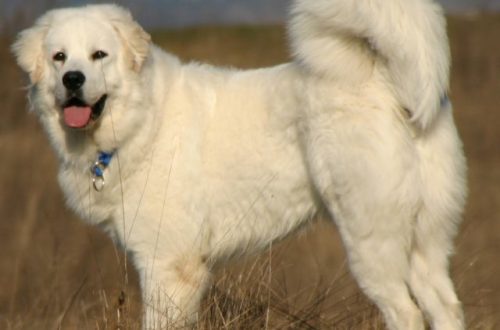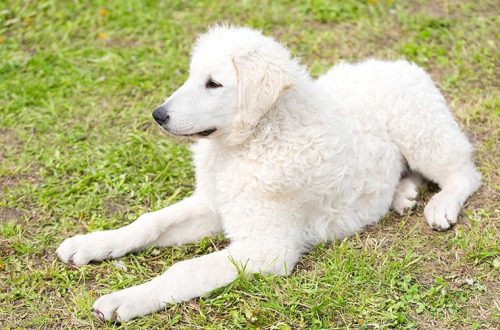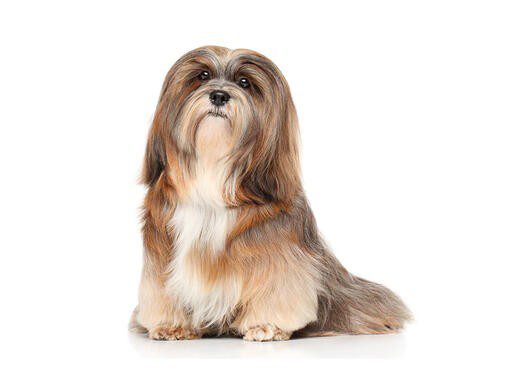
Lhasa Apso
Lhasa Apso is a small but very charismatic native of Tibet; a representative of one of the oldest dog breeds, with a glamorous appearance and independent character.
Contents
Characteristics of Lhasa Apso
| Country of origin | Tibet |
| The size | small |
| Growth | 36-41 cm |
| Weight | 6–7 kg |
| Age | up to 17 years old |
| FCI breed group | companions and decorative dogs |
Basic moments
- The name of the breed is formed from the words lhasa, which means the Tibetan capital, and apso, which means “bearded”. According to an alternative version, Lhasa Apso can also be translated as “a dog that looks like a goat.”
- The Lhasa Apso, like the Pekingese, is considered the ancestor of the Chrysanthemum Shih Tzu dog.
- The breed originates from the ancient southern shepherd dogs, which partly explains the character traits and leadership qualities of its representatives.
- Lhasa Apso are wary of strangers and even after socialization do not cease to suspect strangers of malicious intent.
- The breed is ideal for owners who want to be aware of any intrusions into the territory: dogs consider it their direct duty to bark at everyone who appears on the threshold of the house.
- These Tibetan dogs are the perfect city pets. They are happy to go out with their owners for walks in parks and shopping, but do not require walking for hours.
- Indulging in childish pranks is not in the nature of the Lhasa Apso, so taking a dog into a family with little tomboys who do not know how to properly handle animals is a bad idea.
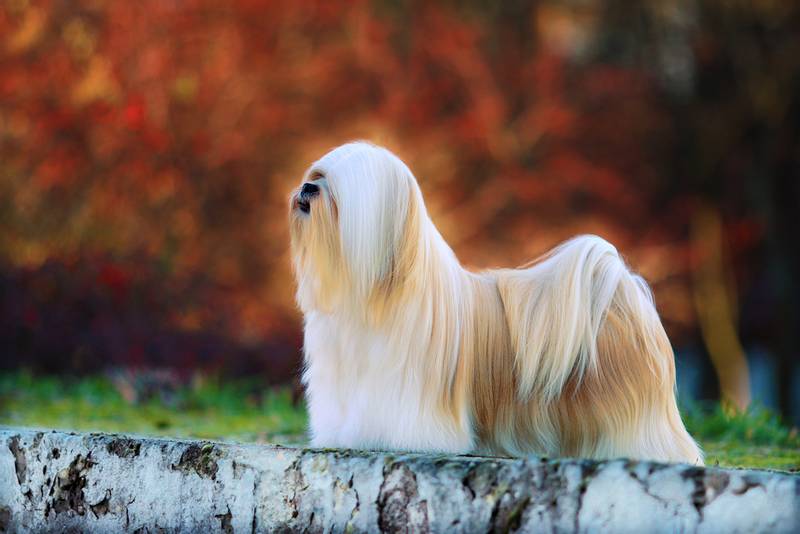
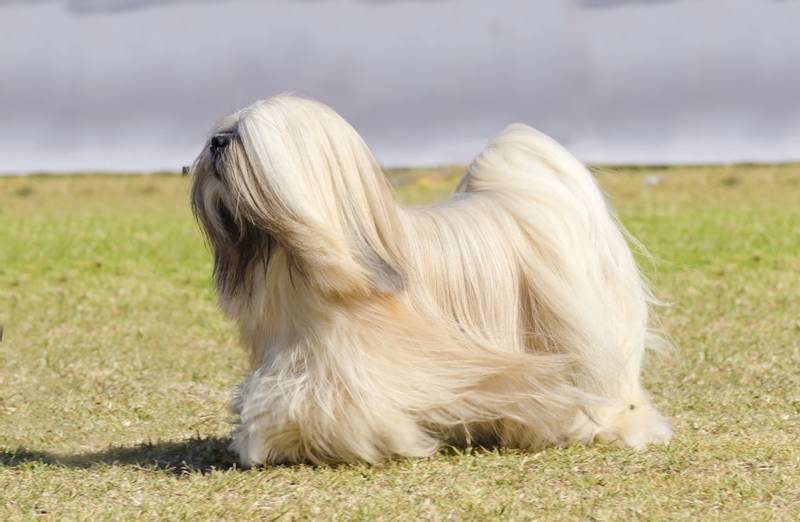
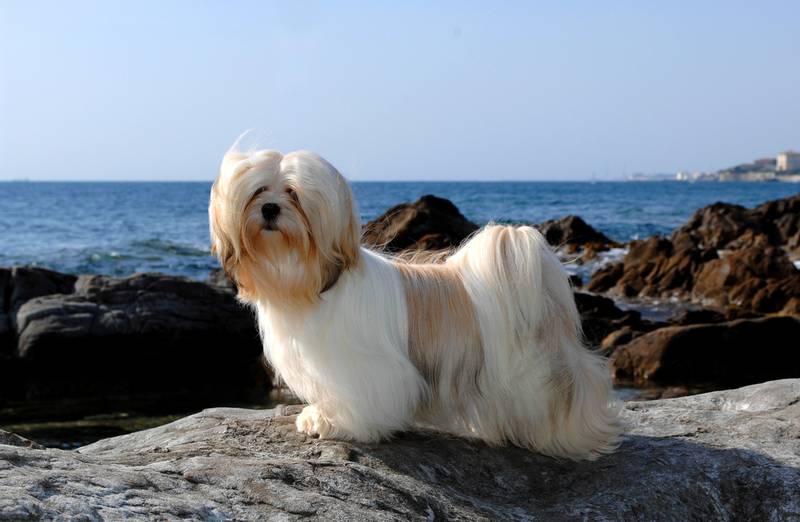
The Lhasa Apso is a self-sufficient intellectual, devoted companion and fearsome owner with the courage of a sheepdog and the appearance of a soft toy. Cunning and largely independent, this “Tibetan” will easily pick up the key to the master’s heart, and if allowed, will gladly begin to lead all family members. However, if you do not delay and have time to besiege the shaggy usurper in time, relations with him can go according to a different scenario – properly educated Lhasa apso make wonderful watchmen, as well as no less sensitive friends of a person.
History of the Lhasa Apso breed
The birthplace of the breed is Tibet, or rather, its monasteries, the inhabitants of which were not indifferent to small dogs, famous for their strong-willed character and sociability. It is known, for example, that the gates of Buddhist cloisters have always been guarded by Tibetan mastiffs , while the status of guardians of the chambers of the Dalai Lamas belonged entirely to the Lhasa Apso. Local beliefs also helped maintain the image of the breed. According to them, the souls of their deceased owners were infused into the bodies of animals, thus continuing their earthly journey.
In praising the breed, the Tibetans went so far as to classify its representatives as sacred animals, the sale of which was severely punished. Sometimes Lhasa Apso was still given, but such offerings were made in exceptional cases and almost always to non-Europeans. That is why dogs came to the Old World only towards the end of the 19th century.
An interesting fact: in their homeland, the Lhasa Apso breed was often called dinner admirers. It was believed that Buddhist monks specially taught dogs to sigh sadly in order to pity the believers. Those interested in the cause of the strange sobs of animals were explained that the dog had not eaten for a long time, but education does not allow him to whine and beg for alms. It is clear that after such stories, the amount of monastic donations increased dramatically.
The British were the first to meet the Apso from Lhasa, but at first different types of individuals were imported into the country, among which there were animals up to 50 cm tall. In England, they decided to divide shaggy dogs into breeds only in the 30s. Thereafter, the larger dogs were named Tibetan Terriers and the smaller ones Lhasa Apso. The Dalai Lama’s dogs came to the rest of Europe later. For example, breeders in Germany saw the breed in the late 30s, the French – in the middle of the 20th century. The “Tibetans” reached the USA by the end of the 50s, and not without adventures: at first, the Americans did not see the difference between the Shih Tzu and Lhasa Apso breeds, mistakenly combining them into one type. It was not until 1969 that dog handlers in the United States managed to separate both dog clans from each other.
Video: Lhasa Apso
Lhasa Apso breed standard
The Tibetan Apso today is a short, sturdy man, as well as the owner of an ultra-long bang, wrapped in a mantle of heavy coarse wool. It is impossible not to note the strong external resemblance of these dogs with their likely relatives – Shih Tzu . However, if you put the breeds side by side, the contrast between their representatives will be brighter. The fact is that the Lhasa Apso is much larger than its relative, and also has a longer muzzle. The optimal height for a Tibetan male is 25-25.4 cm. In general, the height at the withers is considered acceptable if it does not exceed 27.3 cm. Bitches are usually lower and lighter than dogs. If the male Lhasa Apso can weigh from 6.4 to 8.2 kg, then for “girls” the upper limit is 6.4 kg.
Head
The dog’s skull is rather narrow, but neither domed nor flat, with a shallow transition. The muzzle with a flat back is about 4 cm long, which is ⅓ of the length of the head. The head of the animal is covered with luxurious adorning hair, forming a glamorous bang, mustache and beard. The hair on the forehead falls over the eyes, but the view does not interfere.
Nose
The color of the lobe is black.
Teeth and jaws
The standard type of bite for the Lhasa Apso is a reverse undershot bite (necessarily without a break). The incisors of the upper jaw with their outer side touch the inner side of the lower incisor teeth, forming the so-called reverse scissors link. In this case, the incisal line should be as wide and straight as possible. It is desirable that the animal retains all teeth (full dental formula).
Eyes
The harmoniously developed eyes of the Lhasa Apso are of normal size, neither protruding nor deep set. The incision of the eyelids is usually oval, the eyeballs are set straight. An important condition: that the whites of the eyes are not visible either from above or in the region of the lower eyelid.
Ears
For dogs of this breed, the hanging position of the ear cloth is characteristic. The coat on this part of the body is thick, evenly covering the skin.
Neck
The neck should have a strong curve and at the same time look powerful.
Frame
The body of the Lhasa Apso is strong, compactly built, with a level topline and a hardy loin. The ribs are strongly extended back.
limbs
The movements of the dog are characterized by lightness and freedom. Forelegs with sloping shoulder blades and straight forearms. The hind limbs are distinguished by strong muscles and pronounced angles of the articular joints. The hocks are located almost parallel, but at the same time removed from each other, which can be seen when examining the animal from behind. Like the body, the legs are covered with profuse fur.
Tail
Typical features for the Lhasa Apso breed are the high tail set, as well as its position over the back, without curling into a ring. It is acceptable if the tip of the tail is hooked.
Wool
The warm “fur coats” of the Lhasa Apso are the result of adaptation to the harsh temperature conditions of Tibet. The guard hair grows long, hard and devoid of silkiness. The undercoat is moderate but soft, retaining air and warmth well. The coat of the dog does not interfere with her movement.
Color
Lhasa Apso can be of any color. The most typical colors are: golden, brown, black, white, dark gray, honey, two-tone, sand, smoky, bluish-gray.
Disqualifying vices
Lhasa Apso can be excluded from participation in the exhibition only for conspicuous exterior flaws and deformities. Individuals with cryptorchidism, cowardly, showing aggression towards people, as well as dogs whose height exceeds 30 cm do not pass the qualifying round.
Personality of the Lhasa Apso
The appearance of the breed does not at all reflect the character traits of its representatives, so if you expect the Lhasa Apso to be something between a sofa cushion and a children’s toy, then you are mistaken. By nature, small “Tibetans” are closer to shepherd dogs than to decorative tribesmen. Hence the incredible devotion to the owner, distrust of strangers and the desire to take patronage over all two-legged creatures that fell into the field of view.
Lhasa Apso is very attached to people, but does not sink to pestering and annoyingly following the owner on the heels. The breed does not get along well with children, but rather does not consider it necessary to pamper little varmints with their attention and patience. Possessing a developed possessive instinct, the Lhasa Apso is jealous of the fact that children encroach on its toys and territory. By the way, most of the funny conflicts between these two clans occur precisely because of the unwillingness to give in to each other. For example, a dog fiercely defends property, children continue to try to steal a ball from an animal, as a result, the relationship between the “tail” and young hooligans turns into a state of permanent confrontation in the “who wins” style.
If the Lhasa Apso puts kids on a step below itself, then it prefers to be friends with teenagers on an equal footing. For this reason, it is undesirable to trust the training of the dog to the younger members of the family – the “Tibetan” will not obey such teachers. Lhasa Apso is also selective in expressing feelings of affection, therefore it always appoints one person as its own owner. The absence of hypertrophied hunting qualities helps the dog get along with other small pets, while not forgetting to show that she is the “number one” in the apartment anyway.
Living in the same territory with larger fellow tribesmen is not a tragedy for a “Tibetan” if the owner has made at least a minimum of effort to make friends with the dogs. Of course, from time to time the pet will turn on the greedy, grumbling at anyone who touched his couch, bowl or toys, but such behaviors are not corrected. Conflicts with the use of claws and teeth are also not excluded, although not all individuals condescend to a brutal showdown. At the same time, cynologists claim that the grip of the dogs of the Dalai Lamas is no weaker than that of a pit bull , which is why it is incredibly difficult to separate the entangled “tails”.
Lhasa Apso is a playful dog that understands humor and willingly participates in various pranks. However, animals demonstrate all these qualities of their own free will and never at the whim of the owner. So if you need a pet with the makings of a clown, the Lhasa Apso is not the breed that will make your dreams come true.
Education and training
Lhasa Apso are smart and quick-witted dogs, but the innate desire to lead, and, if possible, to suppress, makes them not the most diligent students. At the same time, it is vital to socialize, educate and train the breed, because the “Tibetan”, who has not been instilled with norms of behavior, is still impudent. And of course, in no case do not indulge the animal so that it does not form the so-called small dog syndrome, which manifests itself in spoiled and uncontrollable antics.
When raising a puppy, always pay attention to behavior correction. Stop the dog’s attempts to bite you, do not pick up the barking dog in your arms to console you, do not avoid meeting other, larger “tails”. Lhasa apso must understand that for the owner he is not the center of the universe, but just a junior comrade.
The breed does not work under compulsion, which greatly complicates the process of training, so build classes so that the Lhasa Apso can get carried away. Do not give a command if you are absolutely sure that the puppy will not follow it. Always set achievable goals and encourage your pet to take action. Remember: good or not, but the animal must fulfill the requirement. This approach disciplines and does not allow the pet to think that the orders of a person can be circumvented.
Positive reinforcement during the learning process is essential, but do not try to feed the “Tibetan” with treats so that in the future he does not lose interest in his usual diet. But the punishments will have to be applied very carefully. The fact is that the Lhasa Apso will never allow itself to be humiliated. As an example: a dog will certainly snap at any shout, and will perceive hand waving as a final undermining of trust.
To convince the pet that he is wrong, a strict reprimand in an even, non-ingratiating tone is enough. In extreme cases, a shaggy disciplinarian can be lightly flicked on the nose with a fingernail or newspaper. Do not use a leash for physical impact: having received a strap on the sirloins, the Lhasa Apso will simply refuse to walk on a harness, because it will cause negative associations.
Maintenance and care
Like any decorative pet, the Lhasa Apso loves comfort. In addition, he is a big owner, therefore, in order for the dog to feel as free as possible in the house, she needs property – toys, a bed, bowls for food and water. The Lhasa Apso prefers to own all this belongings on his own, furiously barking at those who encroach on his wealth.
Shaggy “Tibetans” are not hyperactive, but they like to take a walk, so 1-2 times a day the ward should be taken to the promenade. At home, it is recommended to provide a pet with a tray. The Lhasa Apso has a small bladder capacity, they are simply not able to endure with a toilet before walking.
Grooming and hygiene
The main advantage of Lhasa Apso wool is that it has no smell. Even if the animal had to skip a scheduled bath, his hair will not exude canine “ombre”. But you will have to work hard to maintain the spectacular appearance of the dog, but you need to prepare for this nuance before buying a puppy, the Lhasa Apso is not a breed for the lazy.
The outer coat of dogs is heavy and coarse. The undercoat is not very abundant, but this does not prevent it from forming tangles, so the animal needs to be combed daily. There is a special variety of the breed, whose representatives have an overly developed undercoat that cannot be disassembled with a comb. Such individuals are sheared, although, according to the generally accepted rule, a radical shortening of the coat is contraindicated for the breed.
Teach the Lhasa Apso to grooming from an early age: dogs do not respect such procedures, as they remind the owner with whining, attempts to bite the hand and other unpleasant tricks. Representatives of this breed are always combed according to the growth of wool, forming an even parting in the middle of the back. From the age of 3 months, the bangs above the eyes are pulled together with elastic bands into two tails, and as the dog grows older, into four. In the future, such manipulations will help to lay down the hair more effectively. It is also better to collect the mustache and beard in ponytails – so they will be less dirty while eating. Every time after the pet drank water and ate his portion, do not be lazy to wipe his chin and mustache with a clean cloth.
The most difficult care for white Lhasa Apso, because their coat turns yellow from the wrong diet and cosmetic products. Owners of such individuals will have to invest in dry shampoos and talcum powder, which will help whiten the dog’s coat. In addition, white apso need to be bathed more often.
They wash the animal once a month and always use an air conditioner so that the coat fits better. Exhibition individuals are recommended to arrange a bath at least once a week. It is allowed to dry the dog’s hair with a hair dryer, but along the way it must be worked out with a brush to avoid tangling. Washing the anus and genital area will have to be done more often to keep the appearance neat. In addition, the hair under the tail should be trimmed regularly for hygienic purposes – it is more convenient for the dog to go to the toilet, and it is easier for the owner.
It is also useful to remove the hair between the fingers – curved scissors with a rounded tip are suitable for this. It is allowed to leave hair on the paws if a frosty winter is coming, and the pet does not intend to give up walking. In such cases, wool will perform the function of a natural insulation.
Be sure to wipe the eyes and ears of the Lhasa Apso if you notice dust and sulfur secretions in them. A couple of times a week, it is advisable to “persuade” your pet to brush your teeth. By the way, in the case of this breed, it is better to replace the silicone nozzle on the finger with a children’s brush – the “Tibetans” are not enthusiastic about brushing their teeth and sometimes they can click their mouths warningly.
Feeding
An acceptable diet for the breed can be both “drying” and natural products. The first option is preferred by the owners of show individuals – it is always easier to organize pet food using industrial feeds when traveling to exhibitions. The natural menu has its advantages, since the owner independently controls the quality of the purchased products. The only caveat is the constant need to add purchased vitamins and mineral complexes to the diet, compensating for the lack of nutrients in ordinary food.
Basic components of natural nutrition for Lhasa Apso:
- lean meat and liver;
- boiled fish fillet (once a week or less);
- cereals – buckwheat, rice, oatmeal;
- low-fat dairy products;
- quail eggs;
- greens, vegetables, berries and fruits (exclude: potatoes, legumes, citrus fruits, grapes).
To improve the condition of the coat, you can add a little vegetable unrefined oil and fish oil to the feed. Soft cartilage, veins and other substandard conditions are suitable as useful delicacies. And of course, it is important to remember that ½ to ⅔ of a dog’s serving is always meat and only the rest is cereals and vegetable supplements.
Health and disease lhasa apso
Lhasa Apso are distinguished by good health, but even this fact does not guarantee that the dog will definitely live the years allotted to it, never getting sick. Ailments that can be detected in the breed:
- von Willebrand’s disease;
- distichiasis;
- dislocation of the kneecaps;
- progressive retinal atrophy;
- joint dysplasia;
- hypoplasia;
- urolithiasis disease.
The head of the Lhasa Apso, although not as flattened as that of the Shih Tzu, still has a brachycephalic body type. This means that occasionally the animal may experience shortness of breath and difficulty breathing.
How to choose a puppy
- If you plan to purchase a pair of puppies, try to choose a male and female. Lhasa apso loves to fight with fellow tribesmen, especially often conflicts occur between same-sex individuals.
- For breeding and participation in exhibitions, it is necessary to take puppies at least 10 months old. In small Lhasa Apso, the conformation potential is not fully revealed.
- Even if you buy a dog exclusively “for yourself”, ask the seller for a puppy metric to be sure of the purebred pet.
- When choosing a Lhasa Apso puppy by color, keep in mind that as the animal grows older, the coat often changes colors and changes tone.
- Pay special attention to the size of the dog’s nose. In a three-month-old Lhasa Apso, the length of the muzzle should not exceed 2.5-2.8 cm.
- It is advisable to get acquainted with the manufacturers of the litter, or at least see their photos. Moreover, it will be better if the breeder provides amateur pictures, and not studio photos, where the pet is perfectly combed, and its exterior defects are masked.
- Carefully inspect the puppy you like. The Lhasa Apso breed is bred in several types: there are lines that are richer and poorer dressed; in addition, some breeders offer babyface puppies that have a more pretty expression of muzzles.
- Resist the charm of overly soft, fluffy babies. Having matured, such a Lhasa Apso will cause a lot of trouble: due to the abundance of downy undercoat, his “fur coat” will constantly fall off.
Price lhasa apso
Despite the fact that the breed is considered rare, it is easy to find advertisements for the sale of Lhasa Apso puppies on the Runet. The average cost of a healthy, vaccinated animal from a nursery is 30,000 – 50,000 rubles. Pets without the right to breed are sold cheaper and can cost around 20,000 rubles.




